
E-mail: font@focusonnature.com
Phone: Toll-free in USA 1-888-721-3555
or 302/529-1876
 |
PO Box 9021,
Wilmington, DE 19809, USA E-mail: font@focusonnature.com Phone: Toll-free in USA 1-888-721-3555 or 302/529-1876 |
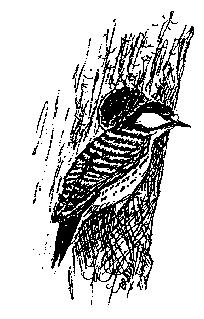 A
Narrative RELATING TO carolina
birdS
A
Narrative RELATING TO carolina
birdS
AND FOCUS ON NATURE TOURS IN NORTH CAROLINA
"Nothing
much Finer than Birding in Carolina"
The drawing at right is of the
Red-cockaded Woodpecker,
an endangered species that we enjoy seeing during
FONT North Carolina Birding & Nature Tours
(drawing by Sally Brady)
Links:
List of Birds during FONT
North Carolina Tours (with some photos)
Mammals (Land & Sea) during FONT North Carolina Tours (with some photos)
Butterflies, Moths, Dragonflies, & Damselflies in North Carolina (with some photos)
Reptiles & Amphibians in North Carolina (with some photos)
Upcoming FONT Birding & Nature Tours in North Carolina
The narrative below was written by Armas Hill, after the FONT North Carolina
land-birding tour in June 2004:
Since 1992, during the late-spring, FONT has conducted a land-birding tour in eastern North Carolina for bird specialties. And with good reason, as it is, and has been for a long time, a great place for birds and for those who have either studied or enjoyed them.
During our most recent tour in North
Carolina, we visited 3 regions:
the
river-bottom forest of the upper Neuse
Valley,
the pine-woods and other habitats of the
central North Carolina coast,
and areas of the northern
Outer Banks. Roanoke Island, and the nearby mainland.
Due to the Carolinas' role in
ornithological history, a number of birds have been actually become identified
as "Carolinean". Probably more birds are in that category than
even many bird enthusiasts realize.
Obvious are the CAROLINA CHICKADEE and the CAROLINA WREN.
And such identification has normally becomes permanent. In one case, that of the
CAROLINA PARAKEET, the name has unfortunately outlived the bird.

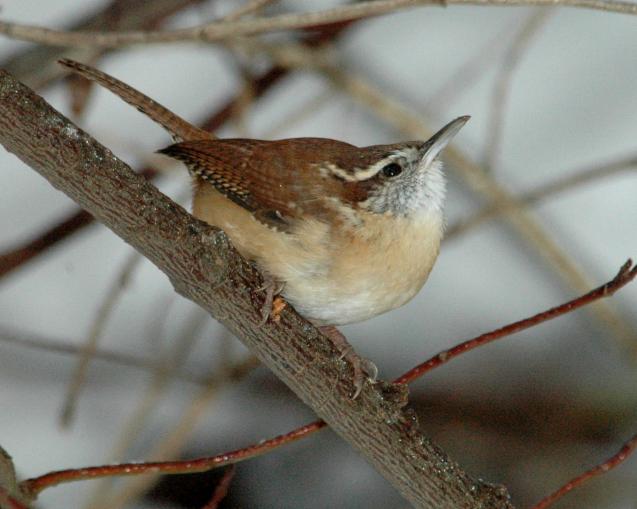
Other birds labeled "Carolinean" may not as quickly come to mind,
particularly those with the reference in their scientific names.
Such as:
Caprimulgus carolinensis, the CHUCK-WILL'S-WIDOW,
Sitta carolinensis, the WHITE-BREASTED NUTHATCH,
Melanerpes carolinus, the RED-BELLIED WOODPECKER,
Dumetella carolinensis, the GRAY CATBIRD,
Pelecanus occidentalis carolinensis, the BROWN PELICAN,
Pandion haliaetus carolinensis, the OSPREY,
Zenaida macroura carolinensus, the MOURNING DOVE,
and one of the birds with "Carolina" in its common name also has the
reference in its scientific nomenclature - the CAROLINA CHICKADEE is Poecile carolinensis.
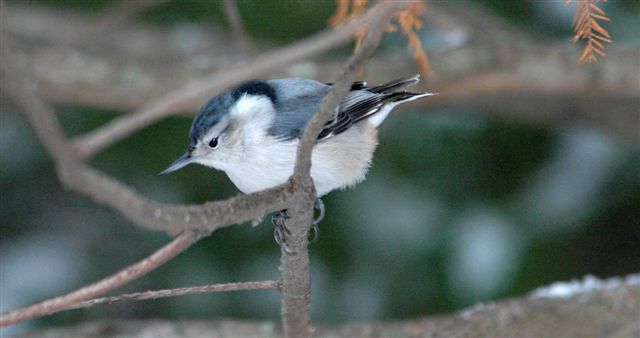
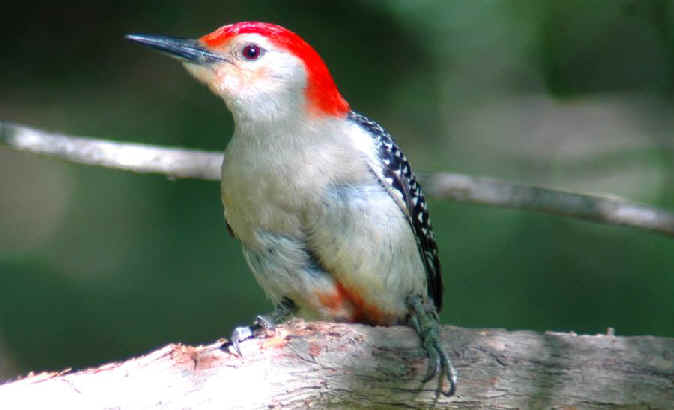
Red-bellied Woodpecker,
Melanerpes carolinus
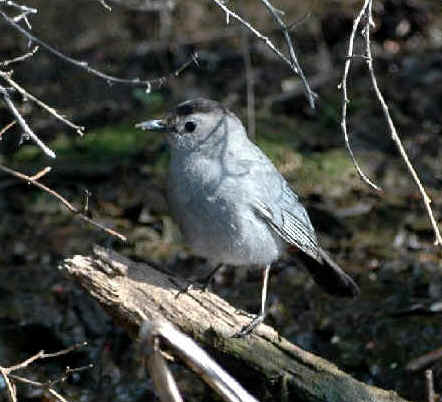
Gray Catbird,
Dumetella carolinensis
All of the birds noted here so far have been seen during our North Carolina land-birding tours (with the exception, of course, of the CAROLINA PARAKEET).
And the above list of birds with a
Carolinean name identity is not exhaustive. There are more:
Porzana carolina, the SORA,
Euphagus carolinus, the RUSTY BLACKBIRD,
Junco hyemalis carolinensis, a subspecies of the DARK-EYED JUNCO,
and Anas crecca carolinensis, what has been the American form of the
GREEN-WINGED TEAL. If considered distinct from the Eurasian form, the separate
species would be Anas carolinensis.
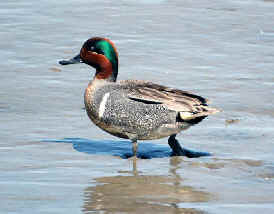
And, interestingly, some forms of
wildlife other than birds that are named "Carolinean" include:
Terrapene carolina, the EASTERN BOX TURTLE,
Anolis carolinensis, the CAROLINA ANOLE,
and in the mammal-department, one that's familiar (maybe too familiar) to
all of us:
Sciurus carolinensis, the EASTERN GRAY SQUIRREL !
and one with which most of us are not very familiar:
Blarina carolinensis, the SOUTHERN SHORT-TAILED SHREW.
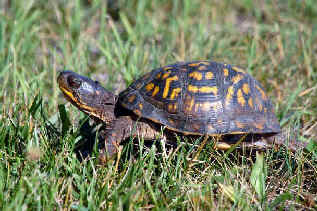
And yet one more creature labeled "Carolinean" was one that we heard during twilight in pinelands, where BACHMAN'S SPARROWS sang and RED-COCKADED WOODPECKERS nested. The sound was lamb-like, a nasal "baaa", that came from the EASTERN NARROWMOUTH TOAD, Gastrophyrne carolinensis.
But, regarding birds, part of the reason
why there's so much Carolinean in names is because there was so much early
exploration and bird study that took place in the beginning days of what's now
North & South Carolina.
And in the early 1700's, that was prior to the standardization, as we now know
it, of common, and particularly scientific, names.
The renowned Swedish taxonomist, Carolus Linnaenus, had much to do with that standardizing, in a global sense. His major accomplishment, the publication of his "Systema Naturae" was in 1758. In it, for example, a common bird of the Carolinas, the MOCKINGBIRD, was described. Others were later. For example, it was in 1766 that Linnaenus described the CATBIRD as Dumetella carolinensis.
Much about the early Carolinean avifauna was included in the work published in 1731 by Mark Catesby, entitled the "A Natural History of the Carolinas, Florida, & the Bahamas". Volumes sold in England at 2 guineas each.
Catesby referred to the work by two men who, when in North Carolina, contributed much to early American ornithology, John White and John Lawson.
John White was the first to draw
American birds extensively (he drew 32 species). His work was in a book by John
Lawson entitled "A New Voyage to Carolina", published in 1709.
White actually made 4 voyages to the New World. On the second, in 1587, he went
as the governor of 150 settlers at Sir Walter Raleigh's colony on Roanoke
Island, North Carolina.
(We stay one overnight on that island during our North Carolina tours.)
When John White was on Roanoke Island,
his daughter and her husband, were parents to the first English child born in
America, Virginia Dare. Thereafter, John White had to leave Roanoke Island to go
to England. When he returned to Roanoke Island in 1590, he found little trace of
the colony and none of the colonists who stayed when he left.
A listing of the 32 bird species drawn by John White follows this
narrative.
John Lawson, the author of the book "A New Voyage to Carolina" in 1709, was, prior to that, a co-founder of North Carolina's oldest town, a place named Bath. His book was the first major attempt at a natural history in the New World. It became popular in Europe because of its vivid descriptions of the North American Indians and their customs, but in it also were good descriptions of newly-found birds and animals. Over 100 species of birds were noted in the book, and a listing of them (with names given by Lawson) follows this narrative.
In 1711, Lawson was in a party exploring,
in North Carolina, the Neuse River, determining how far inland it was navigable.
During that venture, he was killed by Indians.
(During our NC tours, some of our best birding is in the upper Neuse River
Valley, particularly at a wonderful reserve called Howell
Woods.)
The feeders at Howell are a wonderful
place to nicely see some attractive birds indeed. Those feeders there are
somehow without Grackles, Starlings, and the like.
Rather, there are (and were
for us during our most-recent tour ) RED-HEADED WOODPECKERS (& 2 other woodpecker species),
EASTERN BLUEBIRDS (called BLEW BIRDS in the days of White, Lawson, and
Catesby), along with BROWN-HEADED NUTHATCH (and the WHITE-BREASTED
NUTHATCH, remember, Sitta carolinensis).
Bright and
colorful AMERICAN GOLDFINCHES and CARDINALS were there in numbers, as a male
SUMMER TANAGER was not far away (called the "SUMMER RED-BIRD" by
Catesby).
Added to the avian mix were CHIPPING SPARROWS and BROWN THRASHER.
A NORTHERN BOBWHITE walked through the feeder area.
Nearby, GREAT CRESTED
FLYCATCHERS were nesting in a tree-hole.
Maybe a dozen RUBY-THROATED
HUMMINGBIRDS were coming to the feeders, with the brilliant gorget of the male,
up close, just dazzling.
It was a nice place to sit in the shade and simply enjoy the birds.
The assortment of habitats throughout the Howell property contains a large number of birds to be enjoyed. At the edges of the woods, there were both BLUE GROSBEAKS and INDIGO BUNTINGS. In the woods, there are numerous WARBLERS (about a dozen species breed) including PROTHONOTARY, HOODED, KENTUCKY, and SWAINSON'S.
But it was a bird most apt to be seen in the sky that we seek and usually see at the Howell property, the MISSISSIPPI KITE. It's a raptor that when it's aerial it can be acrobatic catching insects, particularly dragonflies. This area of the upper Neuse valley has been good for us for the MISSISSIPPI KITE over the years.
(In 2004, by the way, north of North Carolina, MISSISSIPPI KITES caused enjoyment for a number of birders in places such as Maryland and New Jersey. Probably due to the 17-year CICADA.)
During our tour in North Carolina that year, in '04, we did not encountered any 17-year CICADAS (when they were locally common to the north). But we did see at Howell, in addition to the KITES (which nest there), a large number of various DRAGONFLIES (see the list that follows this narrative).
An aside for a moment regarding the name
MISSISSIPPI KITE it's really not as common in Mississippi as it is other places.
It's most common, during the North American summer, in the Central US, in
Oklahoma for example. During the Southern American summer, that's where it is.
Some other birds with common names
relating to a place where the bird is not as common as it is elsewhere include
the CONNECTICUT WARBLER and PHILADELPHIA VIREO.
Some of the "nice birds" that
we've seen, over the years, during our North Carolina tours, seem to be getting less common.
That's the case with one of our best birds, the RED-COCKADED WOODPECKER.
According to Birdlife International, this bird of the pines (LONGLEAF, SHORTLEAF,
SLASH, and LOBLOLLY), declined overall during the decade 1980-90 by about 25 per
cent. It is now limited to about 30 isolated populations, with the most in South
Carolina and Florida. About 50 percent are now in just 6 of those populations.
North Carolina is now the north edge of
the RED-COCKADED'S range. We saw the species in an area where it has
traditionally nested, in the Croatan Forest. But it was only one pair, that we
encountered during our most recent tour - but at an active nest.
RED-COCKADED WOODPECKERS have nested as far north as Maryland in the 1960's (not
many, a few were discovered there only in the 1930's). In the 1970's,
RED-COCKADED nested in Virginia. Now, no longer, as they are not north of
southern North Carolina.
Another bird, that we've enjoyed during our
NC Tours, with a range that's been receding south, is the WILSON'S PLOVER.
The first specimen of the species was, in 1813, collected by Alexander Wilson,
in southern New Jersey (at present-day Cape May). The WILSON'S PLOVER,
until not that long ago, nested north of North Carolina, along the beaches of
the Delmarva Peninsula and New Jersey. It's occurrence now is as a rarity.
During North Carolina tours, a particularly enjoyable venture has been an afternoon boat-ride to an offshore barrier island, where no one lives, and where there are no roads. So, there are no houses and no cars. Only a pristine beach and dunes, by eastern US or Carolina standards, rather unaffected by people. We've walked the beach to the sandy area adjacent to one of the inlets where we've seen well as many as 8 WILSON'S PLOVERS.
One thinks, sometimes, about birds that
appear to be (or actually are) declining.
The RED-COCKADED WOODPECKER and WILSON'S PLOVER have just been mentioned.
At another spot along the Carolina coast, we've seen the RED KNOT, a long-distance
migrant in the Americas that's had a depreciable decline in recent years.
WHIP-POOR-WILLS and NIGHTHAWKS seem, on the basis of our previous experience, to
be declining.
While RED-HEADED WOODPECKERS have been seen at a few places during our North
Carolina tours (particularly where we were looking for the RED-COCKADED WOODPECKER),
that species has declined (and even disappeared) from many places where it
was in the
northeastern US.
Conversely, it comes to mind, that from a beach where we've watched SANDWICH and other TERNS feeding in the water, that the BROWN PELICAN is in greater numbers than it has been in the past. A few decades ago, the species was in trouble. No longer so, as its numbers have increased, and it's expanded north - that bird of the mid-Atlantic coast known as Pelecanus occidentalis carolinensis.
A Carolina bird-specialty of the pinewoods, formerly known as the "PINEWOODS SPARROW" seemed to continue in relatively stable numbers. That bird, most often known as the BACHMAN'S SPARROW, is named after a Carolinean (a South Carolinean) of the early 1800's.
The "Carolinean bird" with which we had the most contact during our evening and after-dark excursions was the CHUCK-WILL'S-WIDOW, Caprimulgus carolinensis. But our best encounter in the dark was when, as we were going along a remote dirt road, we heard in a roadside tree, a young owl. We stopped the vehicle, and within moments, there was an adult BARRED OWL, that also came on the scene. It was looking directly at us, with its big brown eyes, just a few feet away, in the shine of our headlights.
But a bird that we enjoyed as much as (if
not more than) any other during the tour was one that would come out to sing up
in a tree and atop a bush late in the afternoon, the PAINTED BUNTING. It reaches
the northern limit of its breeding range along the southern North Carolina
coast. What a nice bird, the adult male is to see, with bright blue, green, and
red.
It was a target to be seen for all of us, and we loved it!
Reading about the PAINTED BUNTING in the
historical book noted earlier, written by Mark Catesby in 1731, we learn that to
the south, the Spanish colonists called the bird the "MARIPOSA PINTADA",
the "PAINTED BUTTERFLY".
In that book, we also read that back in those days, it was commonly kept as a
popular caged bird. A governor of South Carolina at that time kept 4 or 5 of the
colorful songsters in cages.
In New Orleans, among the French inhabitants, the bird was also very popular as
a cage-bird. During a visit there, Alexander Wilson wrote of it as being the
most common of the birds kept in homes. A name given to it was 'NONPAREIL".
Of course, the brilliant adult males were favored. It became known that it took
over a year for the males to attain their colorful plumage.
During our tour, we saw a few males, some still dull, others bright.
It's nice to know that nowadays, the only way people enjoy the sight and sound
of the PAINTED BUNTING is as we did, in the wild. (Native birds in the US can
no longer be kept as caged birds.)
Referring to birds in the US, here's a
trivia question of sorts:
Other than some very localized, sometimes recently "split" species
(such as 2 of the Scrub-Jays, the Gunnison Sage-Grouse, Juniper Titmouse, the
re-introduced California Condor, and the Yellow-billed Magpie, actually endemic
to California):
What species are endemic to only the Lower 48 States?
There are not many: RED-COCKADED WOODPECKER, FISH CROW, CAROLINA CHICKADEE, BACHMAN'S SPARROW, BOAT-TAILED GRACKLE.
We saw all of these during our North Carolina tour. (This comes to mind as one year, one of our tour participants was a Canadian, and for him 3 of these species were "lifers" .)
And if you think that one might have been forgotten, the BROWN-HEADED NUTHATCH also resides in the Bahamas.
Some of the best mammal experiences that we've had during our North Carolina tours have been sightings of Black Bears, the Red Wolf, Bobcat, and one time when we came upon a group of 8 River Otters, frolicking together in a pond.
Above, at the beginning of this
narrative, there are listings of birds, as well as
the other wildlife, that have been found cumulatively during the FONT North Carolina
Tours since 1992.
Among those birds is another that lastly should be mentioned here, the Wood
Duck, that has also been known over the years by another name, the
"Carolina Duck".
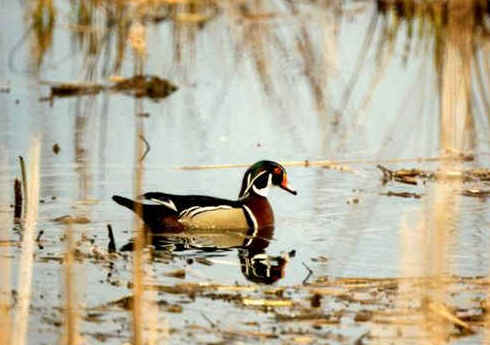
Below, there are lists of birds made by early American naturalists in the
Carolinas in the 1700s, including the first known listing of birds in North
America:
***********************
The first list of North
American Birds
(before taxonomy as we know
it today)
That by John Lawson, in "A New Voyage to Carolina", published in 1709:
Birds drawn by John
White
in Lawson's "New
Voyage to Carolina" (published in 1709)
(John White was the first in America to extensively draw birds.)
The following are the Carolinean birds that were in Mark Catesby's
"Natural History of Carolina, Florida, and the Bahama Islands",
published from 1729-1747:
First, with the name given by Catesby, followed by the modern present-day name.
Those with an (*) were taken from Catesby's work by Linnaeus for his descriptions with scientific names in Systema Naturae in 1758. A total of 71 birds were so used.
Nearly all of the birds in the above historical lists have been seen during our North Carolina spring birding tours. Exceptions were generally the seasonal birds of the winter. And, oh yes, we did somehow miss the Carolina Parakeet, Ivory-billed Woodpecker, Passenger Pigeon, and Whooping Crane.